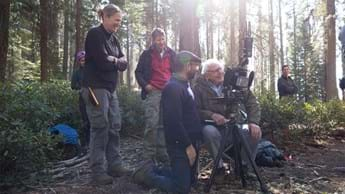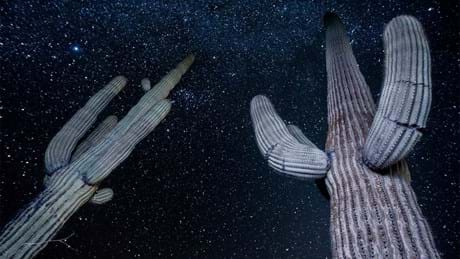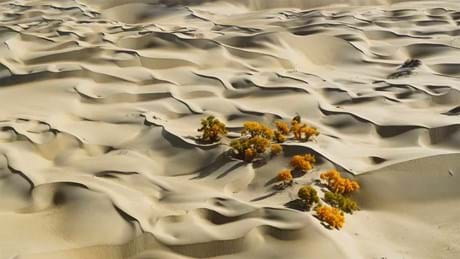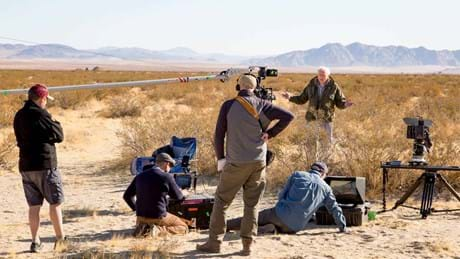Behind the scenes on The Green Planet Season 1
See plants’ cut-throat battles for surviving in dazzling detail BBC’s new nature documentary, The Green Planet Season 1

“We delve into the world of plants to take their perspective, to understand how they live in this parallel universe,” says Mike Gunton, Executive Producer of the new BBC nature documentary The Green Planet. “Because we are human beings, we're very visual, very auditory. We use our senses. And so, we assume all life must sense the planet like that. But if you step through this magical window into the plants’ world, you suddenly see that they experience, or perceive the world in a different way. You have to find a way of using the camera to act as a translator to take you through their secret portal into their world.”
Rosie Thomas, who produced the Seasonal World episode, adds, “In the seasonal film, there's stories about forests where trees can communicate with each other, and they help each other and dying trees will give nutrients to their neighbours, and parent trees are able to preferentially funnel nutrients to their own offspring within a forest, which is fascinating. They also have nervous systems, and they have memory. They are able to smell and have senses. And that there are things that just have never really been explored before in the context of the plant world. I think it's really important that people get to know that side of plants.”
But filming plants across the planet to bring that vision across presented some interesting technical challenges. We spoke to Mike along with Series Producer Rupert Barrington, Paul Williams, who produced the Tropical and Deserts episodes, and Rosie, for a little behind the scenes exploration.
Watch BBC Earth now Set a reminder
Inside The Green Planet
What was the longest time the camera crews spent in the field with 1 plant?
Rupert: “It would have been in the Desert film, there’s a scene where you see saguaro cacti. When it rains, they have this root network that can suck up huge amounts of water and store it in their stems. The stem is pleated, and when they take in water, the pleats flatten out, so the stem increases in size. That’s a really slow process. Our team set up long-term time-lapse cameras on some cacti in Arizona and the cameras ran for 3 years to get this view of the cacti expanding, and then as they lose water, contracting, then expanding again.”
Paul: “Those cameras were taking images of cacti every day for 3 years. Tens of thousands of images came back. We have to filter those images for the best light condition. And then eventually we had these wonderful shots showing the cactus expanding and contracting with the seasons.”

How did you capture your plant sounds?
Rupert: “There’s a brilliant British sound recordist called Chris Watson, who’s very inventive. He has all sorts of strange microphones and listening systems, like needles, which he’ll put into a plant so that he can hear what is going on inside it. For recording sound or small animals under plants, he has what he calls a contact microphone. It's a microphone that is in contact with a surface, say a leaf. And he recorded the sounds of leaf cutter ants running over leaves and chewing leaves and the sound if you're in contact with the leaf, so in a sense, it's the leaf’s perspective on what's going on. The very first sound he sent to me was this weird thing, it sounded like something rattling and straining. He hadn’t told me what it was, but what it was the root of a tree, which he had plugged into, during a storm. And once you knew that you could see that this tree root was just trying to hold onto the soil and not be pulled out by the storm. Chris travelled around with us and did a lot of sound recordings of the plant world using all his clever equipment, to really give us a sense of what the world would sound like to a plant, if plants had ears, rather than what it sounds like to us.”
Tell us a little about the time lapse camera rigs you used in this series?
Rupert: “Time lapse technology probably hasn't changed much for 20 to 25 years. We knew we needed a completely fresh form of time lapse camera system, which would allow us to “fly” into that world and move around that world, as if you're walking into the plants’ world. And we found an ex-military engineer in the United States who, as a hobby in his basement, has built these robotics control systems, which allow a camera to fly in three dimensions any way you want – programmable– and film in time lapse, which was exactly what we were looking for. We partnered with him, and we built some very robust versions of what he had designed. And then we designed smaller systems, which you could take out into the field. That was really the key to taking the viewer in the plants’ world and seeing what it's like.”
Mike: “The engineering relationship we have with this guy and a lot of fancy computer technology meant we were able to have a programmable camera, which could return to exactly the right place to pick up the shot again. So, if you have 2 plants growing, and they're going to fight each other, you can film one shot from here, and then the camera would come around, get the reverse angle shots of this one attacking that one, then it would know to go back exactly to there to pick up the next shot. The camera would be doing both of these shots, in time lapse and with separate feeds. Do you know the film, Rocky? You're in the ring, and you see the shots from Rocky’s perspective, and then you see it from the guy punching’s perspective and then you see it from the fist’s perspective. And then you see it from the crowd’s perspective. That's what we were trying to do, to recreate that kind of Rocky Balboa moment.”
What was one of the most remote places that you shot?
Paul: “We had a Chinese crew film in the Takla Makan Desert of Northern China. The visuals are something I've never seen before. It's a vast, sandy desert. And sticking out of the dunes are these beautiful orange poplar trees. It looks like sunlight from another planet! And how on earth can a tree survive in this desert? Some of these trees have been there 1,000 years. The Chinese drone crew that filmed that sequence for us did an incredible job.”

How deeply was Sir David Attenborough involved in this series?
Paul: “David made the series The Private Life of Plants 25 years ago. Since then, I don't think anybody’s really had the technology, or the bravery to take on plants again. But it's something that David has been pushing for, for quite a while. He was very, very excited when this series got off the ground, and he's been in the field with us a lot over the past few years, we've taken him to the rainforest to the deserts. I was watching Living Planet from 40 years ago. There's an episode about deserts in that film, and I saw David talk amongst this great, big circular plant in the Mojave Desert. It talks about how this is one of the oldest organisms on the planet. It's 12,000 years old. I thought that's amazing. I want to find that. So, 40 years later, I eventually tracked this plant down in the Mojave Desert, the exact same plant where David stood 40 years ago. And we took David back to this exact spot. And working with scientists, we were able to assess that since David was last there, that plant has grown less than one inch. 1 of the remarkable adaptations of desert plants is that they grow so, so slowly. And we used the footage of David from 40 years ago. We fade from David back then to him there now. He's in the same position, and the plant has not changed!”

Now gather your houseplants and sit down with them to enjoy 1 of the most amazing things that TV can do – take us into an unfamiliar world.
Watch The Green Planet Season 1, Sundays at 16:00 on BBC Earth (DStv Channel 184)
BBC Earth (DStv Channel 184) is available on DStv Premium. To upgrade your existing package, click here. Or if you'd like to Get DStv, find a service that suits your needs here.



